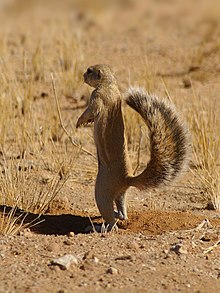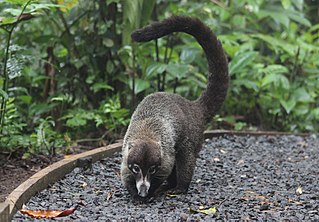
Coatis, also known as coatimundis, are members of the family Procyonidae in the genera Nasua and Nasuella. They are diurnal mammals native to South America, Central America, Mexico, and the southwestern United States. The name coatimundi purportedly derives from the Tupian languages of Brazil.

The meerkat or suricate is a small mongoose found in southern Africa. It is characterised by a broad head, large eyes, a pointed snout, long legs, a thin tapering tail, and a brindled coat pattern. The head-and-body length is around 24–35 cm (9.4–13.8 in), and the weight is typically between 0.62 and 0.97 kg. The coat is light grey to yellowish brown with alternate, poorly defined light and dark bands on the back. Meerkats have foreclaws adapted for digging and have the ability to thermoregulate to survive in their harsh, dry habitat. Three subspecies are recognised.

The mountain zebra is a zebra species in the family Equidae.

The eastern gray squirrel, also known as the grey squirrel depending on region, is a tree squirrel in the genus Sciurus. It is native to eastern North America, where it is the most prodigious and ecologically essential natural forest regenerator. Widely introduced to certain places around the world, the eastern gray squirrel in Europe, in particular, is regarded as an invasive species.

Antelope squirrels or antelope ground squirrels of the genus Ammospermophilus are sciurids found in the desert and dry scrub areas of south-western United States and northern Mexico. They are a type of ground squirrel and are able to resist hyperthermia and can survive body temperatures over 40 °C (104 °F).

Squirrel monkeys are New World monkeys of the genus Saimiri. Saimiri is the only genus in the subfamily Saimirinae. The name of the genus is of Tupi origin and was also used as an English name by early researchers.

The fox squirrel, also known as the eastern fox squirrel or Bryant's fox squirrel, is the largest species of tree squirrel native to North America. Despite the differences in size and coloration, it is sometimes mistaken for American red squirrels or eastern gray squirrels in areas where the species co-exist.

Xerini is a tribe of ground squirrels occurring in Africa and Asia. With the tribes Marmotini and Protoxerini, they form the subfamily Xerinae. There are three living genera—Xerus, the African ground squirrels; Atlantoxerus, containing the living Barbary ground squirrel of North Africa and some extinct species; and Spermophilopsis, containing the long-clawed ground squirrel of Central Asia.
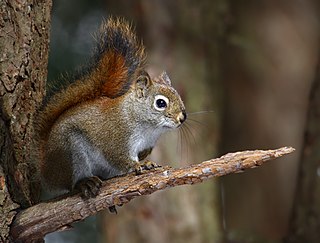
The American red squirrel is one of three species of tree squirrels currently classified in the genus Tamiasciurus, known as the pine squirrels. The American red squirrel is variously known as the pine squirrel, North American red squirrel and chickaree. It is also referred to as Hudson's Bay squirrel, as in John James Audubon's work The Viviparous Quadrupeds of North America. The squirrel is a small, 200–250 g (7.1–8.8 oz), diurnal mammal that defends a year-round exclusive territory. It feeds primarily on the seeds of conifer cones, and is widely distributed across North America wherever conifers are common, except on the Pacific coast, where its cousin, the Douglas squirrel, is found instead. The American red squirrel is not found on most of the Great Plains or in the southeastern United States, except for the Blue Ridge Mountains, as conifer trees are not common in those areas.

The Central American squirrel monkey or, also known as red-backed squirrel monkey, is a squirrel monkey species from the Pacific coast of Costa Rica and Panama. It is restricted to the northwestern tip of Panama near the border with Costa Rica, and the central and southern Pacific coast of Costa Rica, primarily in Manuel Antonio and Corcovado National Parks.

The red-fronted gazelle is widely but unevenly distributed gazelle across the middle of Africa from Senegal to northeastern Ethiopia. It is mainly resident in the Sahel zone, a narrow cross-Africa band south of the Sahara, where it prefers arid grasslands, wooded savannas and shrubby steppes.
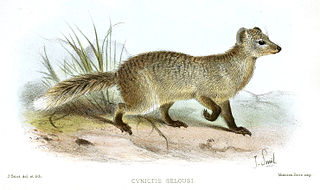
Selous's mongoose is a mongoose species native to Southern Africa. It is the only member of the genus Paracynictis.

Smith's bush squirrel, also known as the yellow-footed squirrel or tree squirrel, is an African bush squirrel which is native to woodlands of the southern Afrotropics.

The Cape ground squirrel or South African ground squirrel is found in most of the drier parts of southern Africa from South Africa, through to Botswana, and into Namibia, including Etosha National Park.
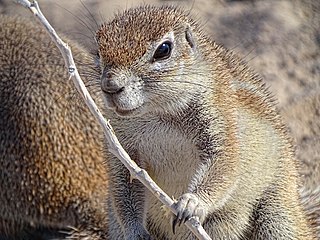
The mountain ground squirrel is a rodent that is native to southwestern Angola, western Namibia, and western South Africa. It is also known as the Kaoko ground squirrel or the Damara ground squirrel.
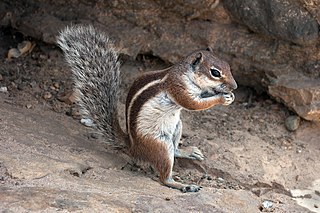
The Barbary ground squirrel is a species of rodent in the family Sciuridae. It is monotypic within the genus Atlantoxerus. It is endemic to Western Sahara, Algeria, and Morocco, and has been introduced into the Canary Islands. Its natural habitats are subtropical or tropical dry shrubland, temperate grassland and rocky areas where it lives colonially in burrows. It was first described by Carl Linnaeus in his landmark 1758 10th edition of Systema Naturae.

Townsend's ground squirrel is a species of rodent in the family Sciuridae. It is found in high desert shrublands in several areas of the United States.

Xerus erythropus is a species of squirrel native to Africa. It was first described by Geoffroy in 1803, but the original publication may be unavailable, so that the binomial authority is today more often cited as "Desmarest, 1817". There are six subspecies. It is a moderately large ground squirrel with sandy-brown or dark-brown fur with a white lateral stripe and whitish underparts. Adults live alone or in pairs in a simple burrow with a central nest, foraging, mostly on the ground, for seeds, nuts and roots, and caching excess food under stones. This is a common species with a wide range and the International Union for Conservation of Nature has rated its conservation status as being of "least concern".

The unstriped ground squirrel is a species of rodent in the family Sciuridae. It is found in Djibouti, Eritrea, Ethiopia, Kenya, Somalia, Sudan, Tanzania, and Uganda. Its natural habitats are dry savanna and subtropical or tropical dry shrubland.

The drill is a primate of the family Cercopithecidae, related to baboons and even more closely to mandrills.
